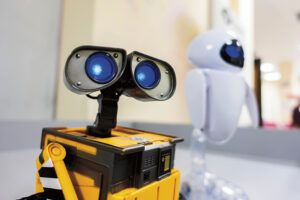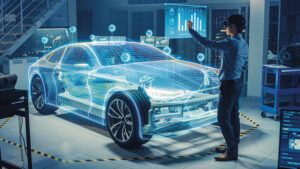From Sci-Fi to Reality – The Parallels of ‘Wall-E’ And Today’s World
Concept of a futuristic business meeting being held in the metaverse.
Discussing the current environment of humans and technology at the Boundaries of Humanity Public Symposium hosted by Stanford University, I was reminded of the 2008 Pixar movie, “Wall-E.” Once a memorable nostalgic movie, “Wall-E” may provide answers to questions about humanity in today’s tech-ridden world
The invention of the pen was one of the most revolutionary technological advancements of its time. Following that, we have seen a slew of technological revolutions – automotive, internet, computers, smartphones…the list goes on and on. The 21st century has been one of the most transformative in human history. We witnessed the rise of technologies that were mere imaginations of the sci-fi world. Autonomous vehicles, instant delivery of goods, the metaverse, AR/VR technology, digital-driven face-to-face communication, and now the new popular kid: AI.
We are at a point of inflection where we ask our humanitarian-driven selves: are we headed in the right direction? Is the rise of AI going to support the growth of humans? Are we advancing in technology too fast for humans to grasp? These questions lead to an overarching question: based on depictions in media, are we headed towards a dystopian reality with emerging technology?
Since the beginning of 2023, I have been participating in many talks led by experts in science and technology, policymaking, arts, and humanitarian studies to find the answer to these questions. In every talk, I am always reminded of the 2008 Pixar movie, “Wall-E.”
“Wall-E” was built on the premise of desires for humans. The creators of the movie were portraying a future based on overbearing consumerism and dependence on technology, driving us to our penultimate state. Taking a hyperbolic approach, the film shows a rather dystopian future in a kid-friendly manner. Once a memorable nostalgic movie, “Wall-E” now provides answers to questions about humanity in today’s tech-ridden world. Let’s dig in.
As humans, we are innately lazy creatures and we have become a species driven by desire rather than survival – a point that was recently made in the Boundaries of Humanity Public Symposium, hosted by Stanford University. Answering the question of whether technology will be a tragedy for humans or transcendence; researchers, subject matter experts, and emeritus professors highlight the importance of defining the moment we are in today – a point of inflection for humans.

The Natural World Around Us, Becomes Less Natural
In the opening scenes, we see a robot compacting trash into cubes, preparing them for some kind of building. The machine was put against the backdrop of mountains made of trash – plastics, papers, etc. With a rather sepia tone, there was a lack of green and water. Another element missing: humans. The movie portrays the potential future of Earth, reflective of human ignorance of the environmental impacts of their actions.
Fast forward to 2023, climate change and our environment have taken center stage. Increased rates of deforestation, pollution, and consumption of resources can be correlated to the degradation of our environment and the increased intensity of climate-driven impacts. Thankfully, leaders are taking action and there is an open dialogue by influential figures to lead with a “people over profits” mindset. But is it enough?

Corporate-driven Consumption and Waste
The film highlights the consequences of corporate-influenced consumption with its version of our current tech giants: BnL Corporation. Portrayed as a powerful mega-corporation, BnL influences and drives almost every aspect of human life. BnL commercials would continuously come up on BnL-powered screens. The commercials promoted a lifestyle of ease and convenience. Anything and everything is available with the click of a button. Any desire could be fulfilled with BnL in the Axiom Spaceship.
As the humans sat pretty, glued to their screens, they only did one thing throughout their whole experience in the Axiom Spaceship – consumption. Whether it was consuming content, consuming food, consuming commercials, or exchanging messages through digital means, the central idea was to portray humans in the light of gluttony where all their desires were fulfilled. It was like an addiction that was being fed easily due to accessibility.
In 2008, when the film was released, this idea of corporate dependence and corporate-driven overconsumption seemed extraordinary and comical. Amazon was just gaining popularity at the time. Fast forward to 2023 and the dynamics have shifted significantly. It’s as if we are heading towards the very reality portrayed in these scenes from “Wall-E.” With the rise of food and goods delivery services like Amazon Prime, Instacart, DoorDash, Uber Eats, and various streaming platforms like Netflix, Prime Video, and Hulu, we are more glued to our screens than ever before. We are consuming more than ever before. Our lives are starting to become driven more by consumption and desire over fulfillment of basic needs. This chain reaction is further enforced by the fact that consumerism determines a corporation’s success.
The more we consume, the more money corporations make, and the more incentives corporations enforce to encourage consumerism. I will give a real-life example. I was in the market for some new headphones (yes, I know I am a human consumer as well.) I checked Amazon for a particular set that I had done some research on. The very next hour, every website, every media platform, Google, and even Amazon themselves were advertising the same headphones or a competitor’s product because I was in the market for headphones. Did I ultimately make the purchase? Yes. Am I happy? Yes.
A strong push from mega-corporations in hopes of influencing my decision on this product. Another place where we see overconsumption being an issue and potentially dictating our social environment is social media. More on that as we discuss the role of technology with humans.

Technology Governing Us?
In “Wall-E,” humans are portrayed as overly reliant on technology, isolated to their automated microenvironments. Automated floating chairs take care of their transportation needs. Communication and entertainment through digital screens picturized the concept of isolation, physical and social. Looking at the humans’ dependence on technology when aboard the Axiom, there is a sense of governance by Axiom’s “AI.”
These scenes collectively depict a society where technology has replaced genuine human interaction. All decisions are influenced and driven by technological consumption. This leads to a sense of isolation and disconnection from the natural world. In 2008, this depiction seemed a bit farfetched. Today? Not so much.
With the rise of social media and a dependence on our digital screens, we are addicted to this drug of technology that keeps on giving. A point brought up when discussing the future of technology and governance at the symposium. Social media companies profit from interactions with their platforms. The core ideology is to keep the user hooked and entertained. One of the points discussed in the symposium was the evolution of our social lives with the introduction of platforms like TikTok and Instagram. Virality and influence being the name of the game, humans are unknowingly being governed by the loudest voices of social media. As seen in the film, everyone socializes in the digital landscape behind a screen.
This concept is being played out in real life. Many people are hooked to their digital screens in public places – coffee shops, restaurants, stores, even while driving. We go out to meet people but still tend to “phub” – take a quick peek at Instagram or another social media on the smartphone.
With the rise of similar addictive technologies, we are heading towards uncharted territory. With augmented reality and virtual reality platforms taking effect, time will tell how influenced and stimulated we will be by emerging technologies. How much will we govern tech vs how much tech might govern us? “Wall-E” provides some answers, according to Jack Dorsey. The film might be a cautionary tale about the potential consequences of allowing technology to dominate our lives, even to the point of losing complete touch with reality.
Where Am I Going with This?
Intrigued by the conversations led by the Stanford think tank, I was reminded of an Instagram post that compared our current social and tech environment to “Wall-E.” Deeper analysis and various articles confirmed that we are all inching closer to the reality depicted by a movie in 2008. The symposium had the underpinnings of a wakeup call for humanity.
Humans are oblivious to the implications of technology development for the sake of innovation. Many at the symposium speak of a wisdom and social gap that is widening. The reason is simple – mystification of emerging technologies. Currently, the wisdom gap created by the tech community and consumers gives headway for governance by technology.
According to the symposium, clear and open communication would help close the current wisdom gap, democratize innovation, and give the power of governance back to us. The need for guidance and regulation in tech, and a foundational shift towards humans, is becoming more vital in the current landscape. If you don’t understand why this new dialogue has started, watch “Wall-E,” and you will understand the importance of these discussions.


